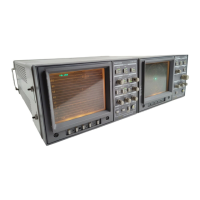1730–Series Checks and Adjustments
5–22
d. Connect the Peak to Peak Detector Head to the 1730–Series PIX MON
output.
e. Connect the Peak to Peak Detector Amplifier Output to the oscilloscope
Vertical input.
f. Set the 1730–Series GAIN to NORMAL and REF to EXT.
g. Set the sine wave generator to 50 kHz (reference frequency) and adjust
the generator amplitude for a 1 Volt display on the 1730 Series.
h. Set the following controls on the Vertical Input:
Volts/Div. 10 mv
Coupling dc
i. Adjust the oscilloscope vertical Position control to place trace on the
oscilloscope CRT center line.
j. Check – that the frequency response is within 30 mV ("3%) of the
reference set on the oscilloscope, as the generator frequency is varied
from 250 kHz to 6 MHz.
NOTE.
! ! !$ #
#" # !$ !
#" #" ! !
% %
15. Check Transient Response
REQUIREMENT – Transient response for the 2T pulse and 2T bar: preshoot
1% or less. Pulse–to–bar ratio: 1:1 within 1%. Overshoot: 2% or less.
Ringing: 2% or less. Tilt: 1% or less for field–rate square wave or 25 ms bar.
Variation of the 12.5T modulated pulse (20T for PAL) baseline (Overscan), less
than 2% as the display is positioned over the middle 80% of the display (with
ac–coupled inputs).
a. Connect the pulse and bar signal to the CH–B INPUT, and terminate the
remaining side of the loop–through connector with a 75W termination.
b. Select the full amplitude 2T pulse and bar signal from the television test
signal generator. Display the signal with the 1LINE SWEEP.
c. CHECK – for less than 1% preshoot and less than 2% overshoot and
ringing for the pulse and bar transitions.
d. CHECK – for a pulse–to–bar ratio within 1% of unity.
e. CHECK – for less than 1% tilt across the bar.

